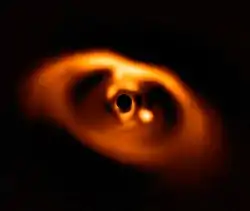Gliese 667 Cb
Gliese 667 Cb is an exoplanet orbiting the star Gliese 667 C, a member of the Gliese 667 triple-star system. It is the most massive planet discovered in the system and is likely a super-Earth or a mini-Neptune. Orbital-stability analysis indicates that it cannot be more than twice its minimum mass. It orbits too close to the star to be in the habitable zone and thus not suitable for life as we know it.[1] Eccentricity analysis indicates that Gliese 667 Cb is not a rocky planet.[2]
 Artist's impression of Gliese 667 Cb if rocky with the Gliese 667 AB binary in the background | |
| Discovery | |
|---|---|
| Discovery date | 2009 |
| Radial velocity (European Southern Observatory) | |
| Orbital characteristics | |
| 0.050432±0.000001 AU | |
| Eccentricity | 0.112 |
| 7.2006 d | |
| Inclination | >30 |
| Semi-amplitude | 3.8 |
| Star | Gliese 667C |
| Physical characteristics | |
| Mass | 5.94–~12 M⊕ |
| Temperature | 473 |
The planet is likely to be tidally locked. Thus, one side of the planet is in permanent daylight and the other side in permanent darkness.[3]
References
- Anglada-Escudé, Guillem; et al. (7 June 2013). "A dynamically-packed planetary system around GJ 667C with three super-Earths in its habitable zone" (PDF). Astronomy & Astrophysics. 556: A126. arXiv:1306.6074. Bibcode:2013A&A...556A.126A. doi:10.1051/0004-6361/201321331. Archived from the original (PDF) on 30 June 2013. Retrieved 25 June 2013.
- "The high multiplicity systems Gliese 667C and KOI 3158". Second Kepler Science Conference. 5 November 2013. Retrieved 27 February 2018.
- Potentially Habitable Planets of Star Gliese 667C Explained (Infographic) - Space.com
This article is issued from Wikipedia. The text is licensed under Creative Commons - Attribution - Sharealike. Additional terms may apply for the media files.
